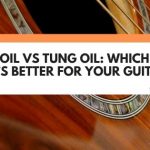It’s often said that wood finishing is more of an art form than a science. Especially when everything, from humidity to temperature, can effect how a finish turns out.
And when it comes to guitar finishes, they are no exception.
Even thinly applied lacquers, poly, and oil finishes can get caught out by an age old finishing issue; air bubbles.
So, why are those bubbles showing up in an otherwise smooth guitar finish? Will they have an effect on the tone of your guitar? Or can you simply ignore them altogether…
Well in this post you’ll learn what exactly what causes those tiny air bubbles to appear in the first place.
You will also find out how to remove them — either from a wet or an already dry lacquer finish.

This post may contain affiliate links to products that we receive a commission for (at no additional cost to you). Learn more here.
First Off, Why Do Guitar Finishes Bubble Up Anyway?
Generally, the two main reasons for bubbling are; drying speed, and the thickness of the finish.
If a guitar finish dries too quickly, it will fast turn into a film. This should be good news, right? A fast-drying finish saves time.
However, in the world of wood finishing, this can prove to be a bit of a problem. Especially when it comes to solvent-based wood finishes like lacquers.
You see, when you combine fast-drying lacquers with fast-evaporating solvents, you create the ideal environment for bubbling.
When solvents vaporize too quickly — yet are trapped inside a quick-drying lacquer — those gaseous solvents will form air bubbles.
Now, lacquer is an incredibly quick-drying finish as it is, and we don’t want it to dry even faster. We need it to dry slowly enough to allow vaporizing solvents time to escape before the lacquer solidifies.
Related Post: Do Roasted Maple Guitar Necks Really Need A Finish?
But Bubbles In A Guitar Finish Will Go Away On Their Own, Right?
If that guitar finish is still wet, then yes, they likely will. Bubbles in a still-drying wood finish aren’t a problem in and of themselves. They tend to rise and pop on their own.
But, they are only able to do this if the finish is applied thinly. Which is where the second main reason for bubbling comes in: thickness of application.
If a guitar lacquer finish is applied too thickly, this can also trap bubbles in the finish. Basically, those bubbles have to make their way through twice as much liquid before they can escape.
Plus guitar finishes that are applied too thickly can dry unevenly too.
Related Post: Why Do Old Solid Wood Acoustic Guitars Sound Better With Age?
Got It. And What Can You Do To Remove Bubbles Out Of Wet Lacquer?
You should try a well-known wood finishing technique called ‘tipping off’.
It’s a simple technique that involves using a bristle brush to pop out the bubbles. This is done by sweeping the very tip of the brush across the finish (sweeping with the grain).
Here’s how it’s done:
Step 1). Use A Clean Brush
Your bristle brush should be clean with no finish on it at all.
Also, use a synthetic bristle brush if you can. Natural bristle brushes can have tiny pockets of air trapped in their bristles (more so than synthetic ones). So, using a natural bristle brush can add more bubbles to a finish, than it removes.
Step 2). Prepare The Brush
Dip the brush into mineral spirits before you begin. And make sure you squeeze off any excess mineral spirit off the brush as well.
IMPORTANT NOTE: When it comes to lacquer finishes, mineral spirits are a mild solvent. Mild enough that it won’t dissolve away solidified lacquer. But stronger solvents, such as Naphtha or Acetone, can dissolve a lacquer guitar finish away completely.
Step 3). Keep The Pressure Off
Move the brush with the grain, and keep things as light as possible. If you start to see the bristles of your brush begin to bend slightly, then you’re pressing down too much.
Got It…But Is There A Way To Get Rid Of Air Bubbles In Lacquer After It’s Dried?
Well, the bubbles in a guitar finish won’t effect your ability to play your guitar. And they will have zero-impact on the sound quality on either electric or acoustic guitars.
However, it can be a coin-flip when it comes how trapped bubbles react to any pressure put upon them.
You see, those bubbles have now created empty pockets of space (in an already thin finish). So, if you press down on them hard while you play, those pockets of air may collapse in on themselves.
And when that happens, they will leave behind a pockmarked finish.
Now, if this were just a case of wood finishing alone, you could simply sand away the bubbles in a dried finish. Yet, sanding off the finish in-between each fret isn’t as straightforward as refinishing a flat tabletop.
So, you’ve got two options at this stage:
Option 1). What To Do If…The Guitar Came Already Finished/Built
Return it and get it replaced.
Something obviously went wrong (or was rushed) in the process of finishing your guitar. So, rather than spend time trying to fix it, make use of the manufacturers guarantee or warranty.
Option 2). What To Do If…If You Built/Finished The Guitar Yourself
If you built/finished the guitar yourself, then you need to remove the finish and reapply it again.
Step 1: Put on some protective gloves.
You are going to be dealing with strong solvents, so let’s try and stay safe.
Step 2: Soak a lint-free clean rag in either Acetone (or alternatively Naphtha).
Squeeze off the excess leaving the rag damp rather than wet. And then swipe the rag back and forth lightly across the lacquer finish.
These solvents are strong enough to actively dissolve away lacquer. And they are your best shot at removing any bubble-filled sections of that finish.
Step 3: Let the surface dry and the solvents evaporate.
Step 4: Reapply the lacquer once again.
But this time make sure it’s very thinly applied.
Related Post: Don’t Use Walnut Oil On Your Guitar Fretboard (Use This Instead)
To Wrap Up, Here Are The 3 Key Takeaways From This Post…
- 1). Tiny bubbles can form in guitar lacquer finishes if the finish has dried too fast. Alternatively, if the finish was applied too thickly, this can cause bubbles to become trapped as well.
- 2). Remove bubbles from still-wet guitar lacquer finishes by ‘tipping off’ the finish. This involves using the tip of a bristle brush to lightly pop those bubbles away.
- 3). If there are bubbles permanently trapped in an already dry finish, you will need to remove the finish altogether. Afterwards, you can reapply it.
References:
Shellac/nanoparticles dispersions as protective materials for wood. Appl. Phys. A 122, 1058 (2016) | Springer.com



